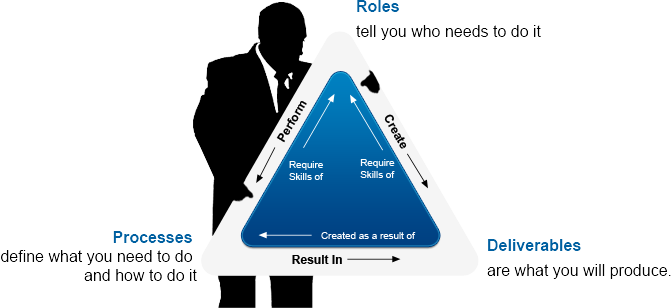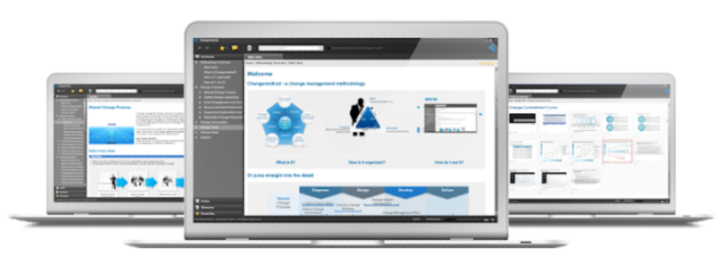Change Management Methodology
Changemethod is a change management methodology that supports the successful implementation of organization change projects and programs. There are 3 core types of content contained which comprise the methodology: processes, roles and deliverables:

Change Management Processes
Processes define what you need to and how to do it. Each area of best practice breaks down into a group of individual processes. Each process, in turn, breaks down into a sequence of steps to follow to complete the process and create the associated deliverables.
The ‘Shared Change Purpose’ best practice area, for example, breaks down into the following processes:
- Define Future State
- Define Change Governance
- Change Management Strategy
- Change Impact Assessment
- Change Management Plan
The ‘Define Future State’ process, for example, then breaks down into the following four steps:
- Identify change imperatives
- Agree change vision
- Define future state
- Identify key change interventions and quick wins
Each process also contains the following content:
- What is it? Why do it? When to do it? This provides a summary description of the process, the main objectives and outcomes as well as a pointer to where along the project timeline it fits in.
- What are the inputs? What are the outputs? These are the change program ‘deliverables’ which are either listed as an input into the process or output from the process. ‘Primary Deliverables’ are crucial to the process whilst ‘Secondary Deliverables’ are useful though not essential.
- Who is responsible? This describes the roles that relate to the process. ‘Responsible Role’ is the one responsible for executing the work, ‘Contributing Roles’ refer to those who may be needed to provide assistance, review, validation etc.
- Related processes. This lists additional processes which relate in the form of overlap or dependency.
Change Management Roles
Roles describe grouped together responsibilities and skill-sets which can then be assigned to an individual and associated with processes and deliverables. An individual may be associated with one or more roles. A role may also be shared by more than one individual.
There are two types of role described within Changemethod:
- Responsible Roles are – as their name suggests – responsible for executing the work. They are accountable for its completion.
- Contributing Roles are those who may be called upon to contribute in some – for example, providing additional delivery support, subject matter expertise or peer review.
Each role is comprised of the following information:
- Responsibilities
- Skills
- Processes the role is responsible for
- Processes the role contributes towards
- Deliverables the role is responsible for
- Deliverables the role contributes towards
Change Management Deliverables
Deliverables are the finalized items of documentation – strategies, analyses, plans, completed worksheets etc. – which are produced as a result of working through the process.
Each deliverable template within Changemethod includes the following:
- Description: a summary description of the deliverable, its purpose, it’s context etc.
- Roles: a list of roles – responsible and contributing – associated with the deliverable
- Template: a template and/or sample of the deliverable in PDF or MS Office and compatible format
- Related Processes: a list of processes where the deliverable is created, updated or used as input
PLUS Change Management Tools
In addition to the core content of processes (what you need to do), roles (who needs to do it) and deliverables (what you need to produce) Changemethod also provides a number of change tools.
The change tools include diagnostic, planning and execution aids ranging from assessment tools to job aids and checklists. You can find them in the ‘what help do I have?’ section of each content guide as well as in context around as you navigate around the methodology.


